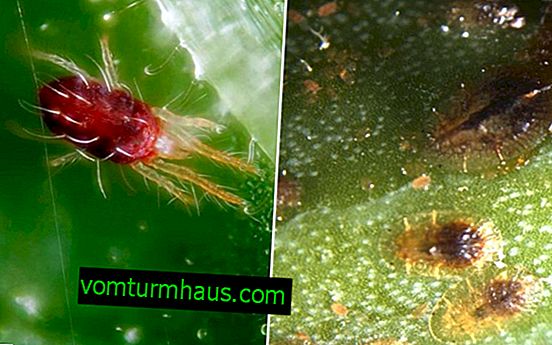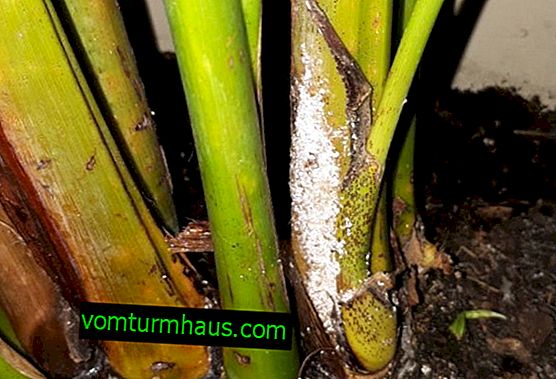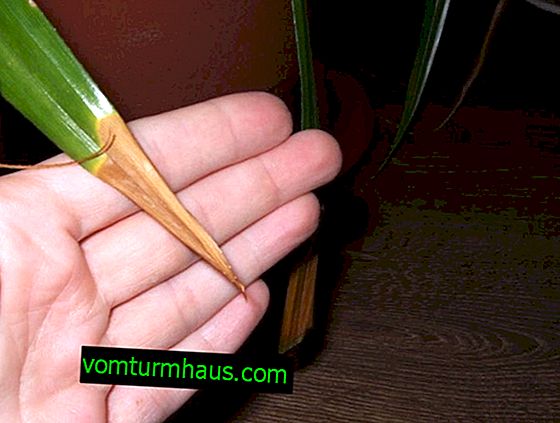How to care for pandanus at home?
Pandanus is a vivid representative of large and beautiful plants that can decorate any interior and do not require complicated care. Due to the spiral arrangement of narrow green leaves on a powerful trunk, this plant is often called a spiral palm. The article describes the external characteristics of the pandanus flower and everything you need to know about it: useful and harmful properties, growing conditions and rules of care, tips for treating possible diseases.
Botanical description of the plant
The natural environment for growing helical palm trees is the tropical zones of Africa. About 600 different species of pandanus are known, among which there are shrubs and tree plants that resemble palm trees.
Did you know? Pandanus growing in the wild can reach a height of more than 15 m!
Botanical characteristic of a flower:
- The plant looks like a bush or tree. When grown indoors, its maximum height is 3 m.
- The root system of the pandanus is branched and thick, but fragile. The roots are able to settle deep in the soil, keeping the tall plant in balance.
- The plant can form aerial roots on the trunk and in the leaf sinuses. In the wild, they gradually sink to the ground and take root in it to increase the sustainability of the pandanus.
- The trunk is short, has a smooth surface and is painted brown.
- The leaves are long, narrow, with small sharp spikes at the edges and in the center. Sheet length - up to 1.2 m, width - 8 cm.
- On the trunk, leaves grow close to each other, forming several rows twisted in a spiral shape.
- In different varieties, green leaves may be monophonic or have white stripes.
- A spiral palm tree blooms every year, but this happens only in the wild. Indoor pandanus does not bloom.
- On the plant spike-shaped male and cone-shaped female flowers are formed.
- Pandanus fruits are large, of various shapes and sizes, formed after flowering. They are edible and taste like pineapple.
- Pandanus is harmless to humans and does not contain allergens. It purifies the air of pathogens, saturating it with oxygen.












Can I keep in the house: signs and superstitions
Pandanus can often be found in offices and conservatories.
Many do not want to grow it at home because of superstitions, for example such:
- a spiral palm absorbs the positive energy of a person as an energy vampire and fills the home with powerful heavy energy, which makes the inhabitants of the house aggressive and evil;
- Pandanus causes insomnia, so it can not be put in the bedroom.
It is believed that pandanus can stimulate mental activity, so it is recommended to place it in offices and other spacious workrooms.
Important! A spiral palm should not be raised indoors with pets and young children, as they can be injured by sharp plant spikes.
Conditions for successful growing at home
Spiral palm can be grown in different rooms. Pandanus indoor is unpretentious to growing conditions and can grow in almost any microclimate. But at the same time, the plant is thermophilic and does not tolerate cold drafts.
Seat selection
Pandanus needs sunlight and plenty of free space, as it is tall and voluminous. You need to put a flower in a spacious bright room with a high ceiling.

Recommendations for lighting and choosing a place for a helical palm tree:
- the flower does not like extremes in lighting - direct sunlight and poorly lit places;
- the plant needs bright, diffuse lighting, which has a beneficial effect on the growth of leaves and stem. Therefore, you need to put a flower near the windows facing east or west;
- when the daylight hours are reduced, the plant needs to turn on artificial lighting. A daylight lamp is suitable, it must be placed at a distance of 1 m from the flower. The total duration of daylight hours in the autumn-winter period should be at least 8 hours;
- spiral palm branches are constantly drawn to the source of light. So that the plant does not deform, you need to regularly rotate it with different sides to the window or lamp;
- Pandanus needs access to fresh air, so in summer it can be taken outside. You need to put a palm tree under a canopy to protect it from falling direct sunlight and rain;
- You can not put the plant on a draft - this can cause yellowing of the leaves.
Temperature and humidity
Pandanus is a thermophilic plant. In summer, he needs a temperature from + 20 ° С to + 25 ° С, and in winter - not lower than + 16 ° С. Small regular airings have a beneficial effect on the palm, but you can’t leave it in a draft.
Did you know? Natives of tropical Africa use the central veins of pandanus leaves for making baskets.
Spiral palm can grow in conditions of moderate humidity - about 60%.
To achieve this indicator, you can use the following actions:
- if it is too dry in a warm room, you can spray the leaves of the plant with water. But it is important to ensure that water does not accumulate at the bases and on the surface of the leaves, as this can cause them to rot;
- you can use a tray with wet expanded clay or moss. A pot of pandanus is placed on a pallet so that its bottom does not come into contact with water;
- To increase humidity and make palm leaves shiny, you can wipe them off with dust with a slightly damp sponge. This procedure should be carried out with gloves so as not to injure your hands on thorns. You need to wipe the dust in the direction from the base of the sheet to its edge.

Care Tips
Despite its large size, pandanus does not require painstaking and complicated care. In order for a palm tree to please the eye with a rich foliage color and grow normally, it is enough to follow the simple recommendations described below. The plant needs proper watering, regular fertilizing and timely transplantation.
Watering
Pandanus negatively reacts to too wet soil, so you need to water it sparingly. It should take some time for the topsoil to dry out.
Consider the basic rules of watering a flower:
- water in the summer once every 2-3 days;
- in winter, watering is carried out every 3-4 days;
- water only with standing water with a temperature of about + 35 ° C;
- it is better to use the method of lower watering - pour water into a pan on which to put a pot of pandanus. The plant absorbs moisture through drainage holes located at the bottom of the tank. After 30 minutes, drain excess water from the sump.
Read also how to care for palm trees such as rapis, butia and chrysalidocarpus.
Top dressing
Even if grown in nutrient soil, a spiral palm tree needs fertilizer.
The frequency of feeding depends on the season:
- in the spring and summer fertilizers are applied every 2 weeks;
- in the cold season, it is enough to feed the plant 1 time per month.

Pruning
Spiral palm does not need pruning. Sometimes, with improper care, the tips of the leaves of the plant may turn yellow, which spoils the appearance of the pandanus. In this case, it is allowed to carefully trim the yellowed edges of the sheet.
In the process of growth at room conditions, the pandanus sometimes forms the so-called stilted roots. Most often this occurs when growing palm trees in a room with high humidity.
These roots spoil the appearance of the flower, but it is strictly forbidden to prune them, as they help the plant maintain stability. So that the aerial roots of the spiral palm do not dry out, they are covered with moistened peat or sphagnum.
Important! In order not to provoke drying of the leaves, you can not cut off their green part.
Transfer
The best time for a flower transplant is late March or early April. The roots of young plants grow rapidly, so in the first 2-3 years of life they need to be replanted every year. After that, you can carry out the procedure once every 2-3 years.
When the roots of the flower begin to stick out of the ground in a flowerpot, this indicates the need for transplanting into a large capacity and fresh soil. Perennial pandanuses growing in huge flowerpots are difficult to transplant. Therefore, if necessary, add fresh soil to the flowerpot or partially change its upper layer.

For plant transplantation, you can buy a standard soil for palm trees or prepare the soil yourself, using such components, taken in equal proportions:
- sheet earth;
- turf land;
- sand;
- humus.
The new flower pot should be slightly larger than the old flowerpot. You can’t choose too much capacity - in excess of soil, the roots of the pandanus quickly begin to decay. Did you know? Pandanus leaves have a sweet taste and are used to make tea.
Spiral palm transplant process:
- Tie and fasten the leaves of the palm so that they do not accidentally break during transplantation and the thorns do not scratch the skin.
- Lay coarse sand for drainage at the bottom of the pot, pour a little earth on top.
- Carefully remove the pandanus from the old pot with an earthen lump around the roots.
- Transfer the plant to a new pot, lightly sprinkle the roots with earth. Deep digging them is not recommended, so as not to provoke rotting of the root system. The upper roots should be slightly visible through the soil layer.
If you transplant a flower often, it will grow faster. To slow down the growth of pandanus, you need to less often transplant it into new soil and a pot.
Video: How to transplant a pandandus
Propagation at home
Indoor pandanus can be propagated by seeds, cuttings and division of the bush. Each of these methods is characterized by its sequence of actions. Let's consider them in more detail.
Dividing the bush
This method of reproduction is used in the spring. For him, take daughter rosettes of leaves that are formed at the bottom of the trunk or in the axils of the leaves.
The sequence of actions during the propagation of pandanus by dividing the bush looks like this:
- From the mother plant, carefully cut off the daughter leaf outlet. It should have roots at least 20 cm long.
- Dry the daughter sockets in a warm room for a day.
- Put a drainage layer about 2 cm thick on the bottom of the prepared container.
- Put a thick (up to 7 cm) layer of turf on the drainage, and river sand on top. Moisten the soil in a pot.
- Place the base of the daughter outlet in the ground to a depth of about 2 cm. Sprinkle the roots and compact the ground around the roots.
- Cover the container with the daughter plant with plastic wrap until it is completely rooted. This process takes up to 30 days.
- To make rosettes better rooted in the soil, they must be kept at a temperature not lower than + 25 ° С. You can use the bottom heating of the pot.
Important! To quickly grow roots on rosettes, their bases are wrapped with moist moss.
Cuttings
Propagating the pandanus by cuttings is simple, but for a successful result you need to adhere to some recommendations.
Consider the algorithm of actions with this method of reproduction:
- Cut the cuttings from the lateral branches of a palm tree. So that they are better rooted, their length should be at least 20 cm.
- Treat the cut points with powdered activated carbon. For faster and better rooting, you can use a root growth stimulator.
- Prepare a container and fill it with a mixture of sand and peat land.
- Plant the cuttings in a prepared container by immersing one of its slices in the soil to a shallow depth.
- Close the stalk with a film and put in a warm place. To ensure that the cuttings have access to fresh air, the film needs to be slightly opened for ventilation and sprayed with soil as it dries.
- Keep the stem in such conditions for 1.5–2 months. The air temperature under the film should be +25 ... + 28 ° С.
- After this period, rooted cuttings are transplanted into a permanent pot.

Seeds
You can grow the plant directly from the seeds. The optimal time for sowing is from late February to early March. Consider the sequence of actions when growing pandanus from seeds.
- Prepare a container, fill it with a mixture of peat and sand (1: 1 ratio). Instead of peat, you can use leafy land.
- Deepen the seeds in the soil by 1-2 cm, sprinkle a little soil.
- Cover the container with film and leave in a room with an air temperature of about + 25 ° C for 2 weeks.
- Raise the film periodically for fresh air. Spray the soil with seeds with water after drying its upper part.
- After emergence of shoots to remove a film. To carry out moderate watering of seedlings.
- When 3-4 young leaves grow on sprouts, they are transplanted into individual pots.
Possible growing difficulties
Pandanus is very unpretentious in care, but if you neglect the recommendations described above, the plant may become ill or be attacked by pests. Consider a list of possible problems when growing a flower.
- Red spider mite, scab. Insects appear with insufficient watering, lack of ventilation and low air humidity. Pests should be removed with a cotton swab dipped in alcohol. To completely destroy insects, a helical palm is irrigated with a solution of insect repellents.

- Mealybug. Appears in waterlogged soil. The pest leaves a sticky white coating on the leaves, which gradually acquires a brown tint. For treatment, pandanus is irrigated with a solution of Karbofos or Actellic.

- Drying leaf tips. The problem appears with insufficient watering or poor fertilizing of the plant with fertilizers. For treatment, you need to increase the humidity level in the room, more often spray the palm tree with water and timely feed.

- Slowing growth, lightening leaves. In conditions of lack of sunlight, the pandanus grows poorly, and excessive lighting leads to a change in the color of the leaves to lighter. Depending on the reason, the plant needs to be rearranged closer to the light source or further from it.
- Yellowing leaves. The reason may be excess light or too hard water for irrigation. If the leaves turn yellow at the pandanus, then first of all it needs to be moved further from the light source. In the second case, you need to make adjustments to the irrigation mode and use only the settled water.

Pandanus looks beautiful and exotic in any interior. The flower does not need specific care or special microclimate conditions, so even a beginner grower can cope with its cultivation.







